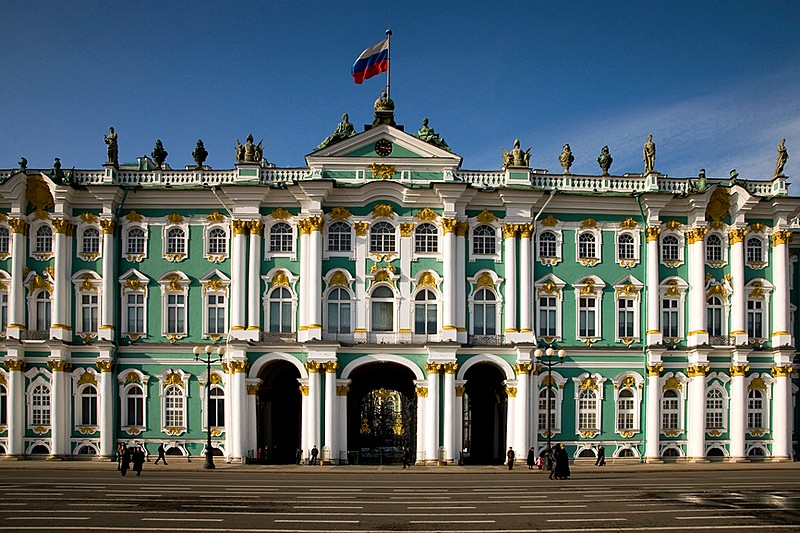Author’s note: Dilara has already written an excellent blog about this palace, but I’ll focus on some other aspects of the residence.
My impressions of the Catherine Palace in Pushkin (formerly known as Tsarskoe Selo) could be summed up in one word: GOLD!! After our weekends in Suzdal and then St. Petersburg, I became convinced that all the gold in the world is actually housed in Russian museums, palaces, and churches, but I digress. The Catherine Palace not only has a rich, interesting history, but is also incredibly beautiful.

The palace is built in the Northern Baroque style. As I understand it, Northern Baroque is distinguished from other Baroque styles by its prominent turquoise and light blue color scheme, which is usually offset with white columns and gold or brown accents. The Hermitage Museum / Winter Palace is another famous example of Northern Baroque.

The Winter Palace in St. Petersburg, photo from http://www.saint-petersburg.com/images/virtual-tour/hermitage3.jpg.
Both the Catherine and Winter Palaces were built by the famous Italian architect Rastrelli. To say Rastrelli left his mark on St. Petersburg would be an understatement. Almeda and I had a game in Petersburg: whenever we found a building we thought might be a Rastrelli [that is, topped with numerous unnecessary statues on the roof or featuring a Northern Baroque color palette], we’d find out for sure, shout “RASTRELLI!” and then tap the other on the shoulder. It was our version of “Slug Bug.”
Catherine, for whom the palace is actually named, came to find the place gaudy, instead preferring clean Neoclassicism. The Empress Elizabeth was the real mastermind of the project, and before her death, she had even made plans with Rastrelli to up the decoration even more. Though the facade is lovely now, all of the brown accents were actually plated gold, and it was probably quite a sight back in the day.

The most interesting thing about the Catherine Palace, in my opinion, is that it was taken over by Nazis during World War II and thoroughly ransacked.

The German Army was not kind to the lavish building. Photo from tsarselo.ru.

Photo from tzar.ru.
Being there today and not being aware of that story, you’d never guess that all that was left of the Catherine Palace was some rough foundation and sections of missing roof and smoldering ruins. The polished parquet floors and gold gilding on the walls shine impeccably, and almost all of the rooms are in order. A painstaking restoration continues to this day, room by room.
A treasure from the original palace was the “Amber Room”, with its walls, decorated with designs made from different shades of amber in mosaic style. Incredibly, the team in charge of restoration had only a few black-and-white photographs and a watercolor painting of the room to base their new design off of.
.jpg)
The whole room is made of shining, liquid gold amber. Photo from http://www.guide-guru.com/files/File/amber_room_3(1).jpg.
While in the palace, I was pondering the idea of “authenticity.” In recreating the Amber Room, the artists stuck to the same, traditional methods as the original. But the fact remains that the walls are all different, all new. Much of the palace is new, but that doesn’t really detract from the experience of it. And if you leave something “original”, even with good, minimal upkeep, it will decay. So my question: should we be striving for preservation or restoration? In this case, restoration was the only option, but it’s interesting food for thought when visiting other historical landmarks in Russia and across the world.
Sources:
http://en.wikipedia.org/wiki/Catherine_Palace
Information given by our excellent tour guide, Valerii.


















